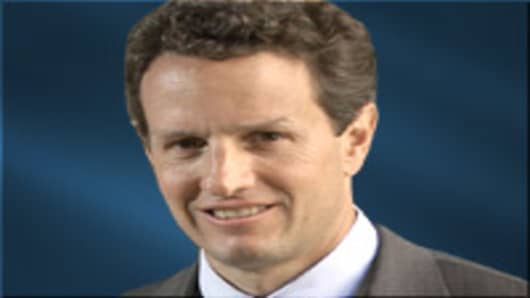They expected firms receiving government aid to lend more to consumers. Many of them now want such firms to be required to participate in foreclosure mitigation efforts.
That Congressional support is seen as key to both the Obama administration’s forthcoming initiatives as well as those that may be needed in the future, which would include the authorization of new funding.
“There has to be some sort of sales job to the people before we go out on the limb and appropriate new money,” said a senior Congressional staffer “Any new money will be largely leveraged on how they do with this money.”
Geithner is also expected to announce plans to widen the scope of a Federal Reserve program worth up to $200 billion that seeks to encourage private investors to buy consumer-credit backed debt. The program is known as TALF, or term auction lending facility.
In a statement Monday, the Treasury said that senior officials from Treasury, the Federal Reserve Board and the Federal Deposit Insurance Corporation would hold a media briefing on the plan at 11:45 a.m. ET.
CNBC Slideshows:
Treasury Secretary Geither met with the Democrats at their caucus retreat in Williamsburg, Virginia Saturday and discussed foreclosure and mortgage loan issues but the details remain unknown at this time.
Geithner will testify before the Senate Banking Committee Tuesday afternoon after his speech and CNBC interview. CNBC.com will carry the event live.
Revisiting Private Capital
Word that the government’s discussions included the private capital concept first surfaced Saturday, but the idea of some kind of private sector involvement dates back to right after Paulson first proposed a government auction of assets last fall.
Rep. Jeb Hensarling (R.-Texas), who was among those in Congress pushing for it in the original TARP legislation, called the current private capital idea "feasible" because there's a lot of it "sitting on the sidelines."
Hensarling, added, however, that he still favors his insurance-based model, wherein firms participating in the asset transactions pay fees.
"In a pure vacuum, I would tend to lean toward an insurance-based model," said Hensarling, who voted against the original legislation and is a member of TARP’s Congressional Oversight Panel.
The funding issue is critical yet potentially complicated, say analysts as well as some in government.
One question is whether the administration might use a multiplier method in backing troubled assets through the ring fence guarantees, rather than a virtual dollar-for-dollar approach.
“And the question is will the Fed participate," as Rep. Brad Sherman D.-Calif.) recently put it in an interview. If so, he says, "it would clearly give the government more money to work with.”
Hensarling shares Sherman’s concerns, saying there "appears to be little check" over the Fed using its balance sheet. “Congress would have to explore statutory authority to limit that.
A senior member of the House Financial Services panel, Sherman like Hensarling, voted against the original TARP and thinks the capital injection is the best approach in using taxpayer money.




